person reid评价指标——CMC原理及代码解析,mAP
CMC
CMC全程是Cumulative Matching Characteristics, 是行人重识别问题中的经典评价指标。该曲线的横坐标为rank,纵坐标为识别率百分比。rank n表示识别结果相似性降序排列中前n个结果包含目标。识别率是rank n 的数目#(rank n)占总的query样本数的比例。如下图
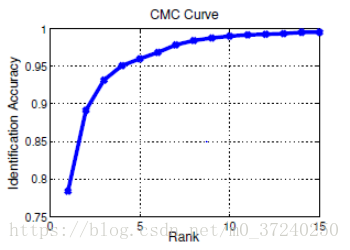
CMC曲线图来源 https://blog.csdn.net/m0_37240250/article/details/79942939
代码解释
先贴代码
代码来源 [港中文Xiaogang Wang教授 主页]
1 2 3 4 5 6 7 8 9 10 11 12 13 14 15 16 17 18 19 20 21 22 23 24 25 26 27 28 29 30 31 32 33 34 35 36 37 38 39 40 41 42 43 44 45 46 47 48 49 50 51 52 53 54 55 56 57 58 59 60 61 62 63 64 65 66 67 68 69 70 71 72 73 74 75 76 77 | function C = cmc(D, varargin)% CMC computes the Cumulative Match Characteristic.% C = CMC(D) computes the CMC of given distance matrix D between each pair% of gallery and probe person. Both gallery and probe persons are% assumed to be unique, i.e., the i-th gallery person matches only to% the i-th probe person. D(i, j) should be the distance between% gallery instance i and probe instance j.% 单个参数C = CMC(D)时表示gallery和probe中的identity都是独一无二的,% 即gallery中第i个person只匹配probe set第i个person%% C = CMC(D, G, P) computes the CMC with G and P are id labels of each% person in gallery and probe sets. D is M*N where M and N are the lengths of% vector G and P, respectively. This function will first randomly select% exactly one instance among for each gallery identity and then calculate% the CMC of this sub-matrix. This procedure will be repeated 100 times% and the final result is the mean of them.% 三个参数C = CMC(D, G, P),G和P是gallery和probe中person的id label,% 所以D的高=G的个数,D的宽=P的个数% 该脚本先对galleray中的每个identity随机挑选一个instance(同一个identity可能有多个instance),% 计算子矩阵的CMC,然后重复一百次,求均值switch nargin% nargin 针对当前正在执行的函数,返回函数调用中给定函数输入参数的数目% nargin(fun) 返回 fun 函数定义中出现的输入参数的数目% 如果该函数定义中包含 varargin,那么 nargin 返回输入数目的负数% 例如,如果 myFun 函数声明输入 a、b 和 varargin,那么 nargin('myFun') 返回% -3,就可以确定varargin前有2个参数 case 1 assert(ismatrix(D)); assert(size(D, 1) == size(D, 2));% 判断是矩阵且是方阵 case 3 G = varargin{1}; P = varargin{2}; assert(isvector(G)); assert(isvector(P)); assert(length(G) == size(D, 1)); assert(length(P) == size(D, 2)); otherwise error('Invalid inputs');endif nargin == 1 C = cmc_core(D, 1:size(D, 1), 1:size(D, 1));else gtypes = union(G, []);%求集合,防止重复label ngtypes = length(gtypes); ntimes = 100; C = zeros(ngtypes, ntimes);%宽是100,有100条曲线求均值 for t = 1:ntimes subdist = zeros(ngtypes, size(D, 2)); for i = 1:ngtypes j = find(G == gtypes(i));%寻找gtypes(i)相同的G中label k = j(randi(length(j)));% j可能有多个值,从中随机选一个 subdist(i, :) = D(k, :);%选取D中对应的行向量(该Label到probe set中每个label的距离的向量) end C(:, t) = cmc_core(subdist, gtypes, P); end C = mean(C, 2);endendfunction C = cmc_core(D, G, P)m = size(D, 1);n = size(D, 2);[~, order] = sort(D);%二维矩阵时,对矩阵的每一列分别进行升序排序,即query中每个label在gallery中相似度的升序match = (G(order) == repmat(P, [m, 1]));%(m*n==m*n),找矩阵中对应相同元素%repmat(P, [m, 1])是以P为unit构建m(unit)X1(unit)的矩阵% G(order)与order/D大小一致,即按照order里面每列的排序重新排列GC = cumsum(sum(match, 2) / n);%sum(match, 2)每行累加%cumsum是将矩阵按列进行求和,每一项是前面之和(类似于积分曲线)end |
原理解释
脚本中单个参数CMC(D)是多参数的特殊形式,这里只解释多参数调用
对于函数调用CMC(D, G, P),定义
- G为gallery中每个人的label向量,大小为Mx1
- P为probe sets(query)中每个person的label向量,大小为Nx1
- D是gallery和probe sets中两两person的特征距离矩阵,大小为MxN,
如下图所示
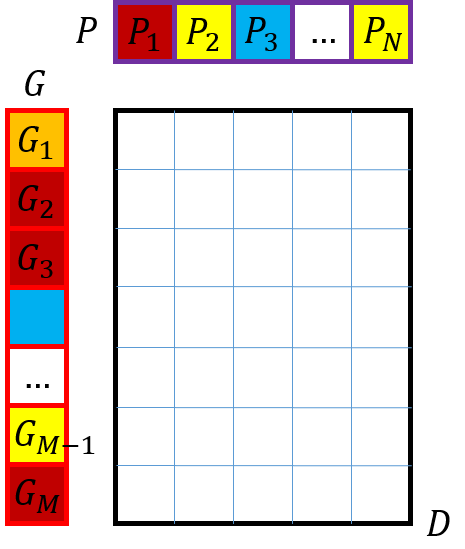
对G中的label求集合,得到G’,即向量中不出现重复的label;
G’中每个label对应的D中的行向量组成新的特征距离矩阵D’。其中,对于某些label在G中多次出现,随机选取其中的一个并抽取在D中的行向量。
如下图所示,G2,G3,GM随机选一个
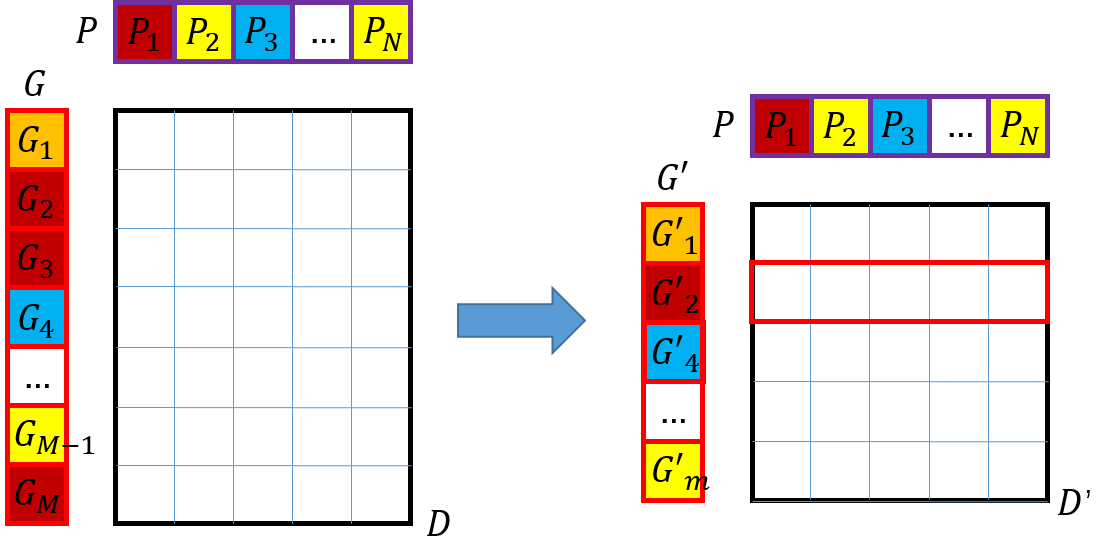
对D’按列进行升序排列,逐列记录下排列顺序的矩阵order,并按照每列的排列顺序重新排列G’(每一列重拍一次G’),得到label矩阵G’(order)。
order获取示例(以一列向量为例):
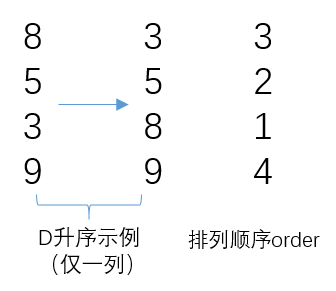
G’(order)如下:
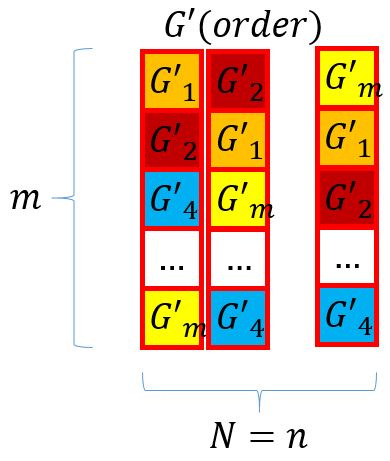
以P为单元复制[m,1]次,得到repmat(P)矩阵
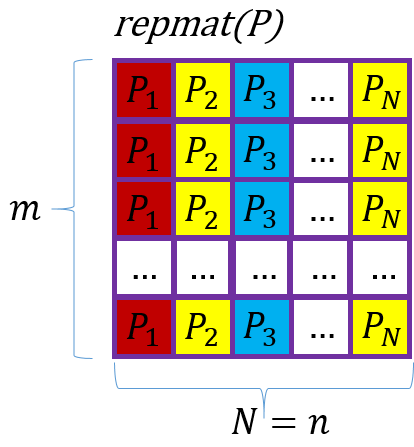
求和G’(order)矩阵中相等的元素的位置,
match = (G(order) == repmat(P, [m, 1]))
得到0/1二值矩阵match,大小为m*n,其中1为该位置处两个矩阵对应元素相等,0为不等
求CMC分数:
C = cumsum(sum(match, 2) / n)
sum(match, 2) / n是对match矩阵按行求均值(m*1),cumsum()是逐列求积分(m*1)。
cunsum示例
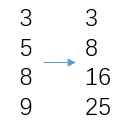
这样就得到了一条CMC中的rank曲线,重复100次求均值即输出。
mAP
Precision & Recall
一般来说,Precision就是检索出来的条目(比如:文档、网页等)有多少是准确的,Recall就是所有准确的条目有多少被检索出来了。
正确率 = 提取出的正确信息条数 / 提取出的信息条数
召回率 = 提取出的正确信息条数 / 样本中的信息条数
准确率和召回率都是针对同一类别来说的,并且只有当检索到当前类别时才进行计算(因为P-R曲线,只在recall的点算,而recall只在TP点算),比如在person re-id中,一个人的label为m1,在测试集中包含3张此人的图像,检索出来的图像按照得分从高到低顺序为m1、m2、m1、m3、m4、m1….,此时
第一次检索到m1,提取出的正确信息条数=1,提取出的信息条数=1,样本中的信息条数=3,正确率=1/1=100%,召回率=1/3=33.33%;
第二次检索到m1,提取出的正确信息条数=2,提取出的信息条数=3,样本中的信息条数=3,正确率=2/3=66.66%,召回率=2/3=66.66%;
第三次检索到m1,提取出的正确信息条数=3,提取出的信息条数=6,样本中的信息条数=3,正确率=3/6=50%,召回率=3/3=100%;
平均正确率AP=(100%+66.66%+50%)/3=72.22%
对Precision求Mean Average等同于求P-R曲线下的面积(积分)
mAP
而当需要检索的不止一个人时,此时正确率则取所有人的平均mAP。
--转载自CSDN





【推荐】国内首个AI IDE,深度理解中文开发场景,立即下载体验Trae
【推荐】编程新体验,更懂你的AI,立即体验豆包MarsCode编程助手
【推荐】抖音旗下AI助手豆包,你的智能百科全书,全免费不限次数
【推荐】轻量又高性能的 SSH 工具 IShell:AI 加持,快人一步
· Linux系列:如何用heaptrack跟踪.NET程序的非托管内存泄露
· 开发者必知的日志记录最佳实践
· SQL Server 2025 AI相关能力初探
· Linux系列:如何用 C#调用 C方法造成内存泄露
· AI与.NET技术实操系列(二):开始使用ML.NET
· 无需6万激活码!GitHub神秘组织3小时极速复刻Manus,手把手教你使用OpenManus搭建本
· C#/.NET/.NET Core优秀项目和框架2025年2月简报
· Manus爆火,是硬核还是营销?
· 一文读懂知识蒸馏
· 终于写完轮子一部分:tcp代理 了,记录一下